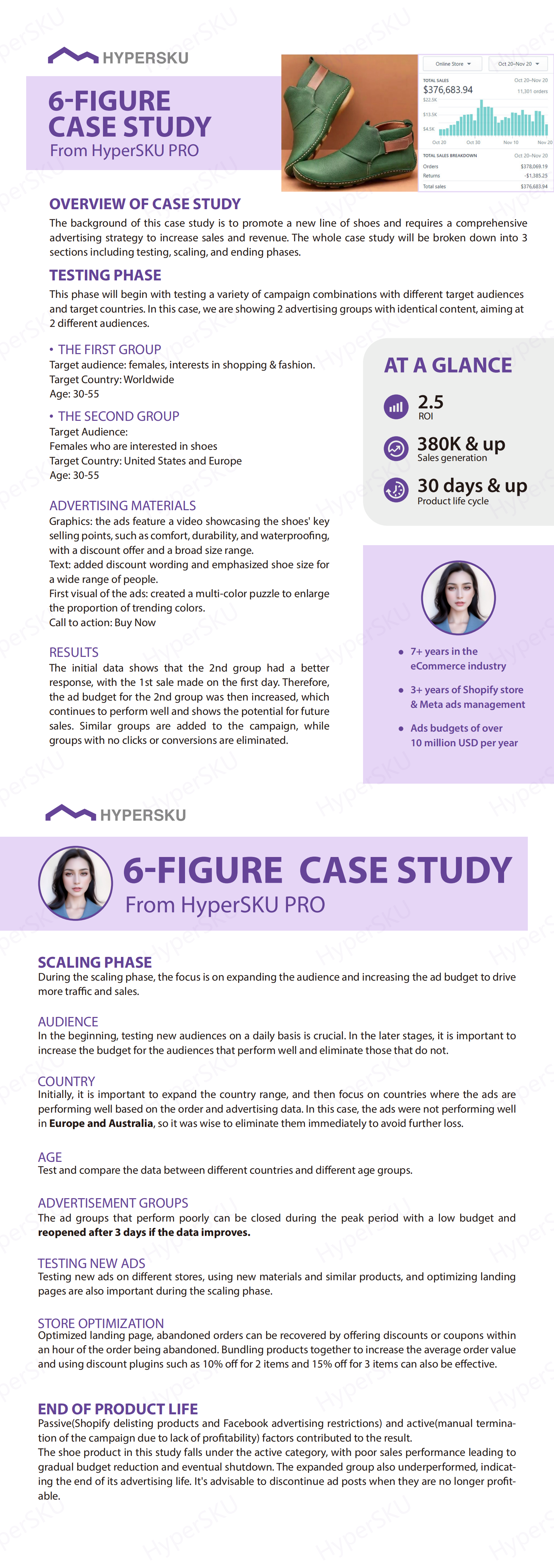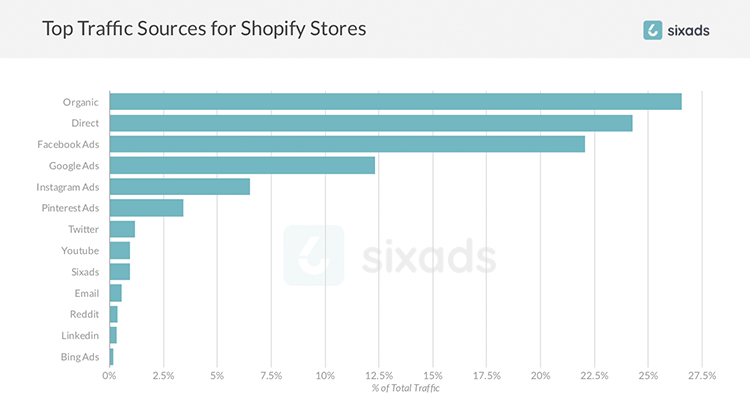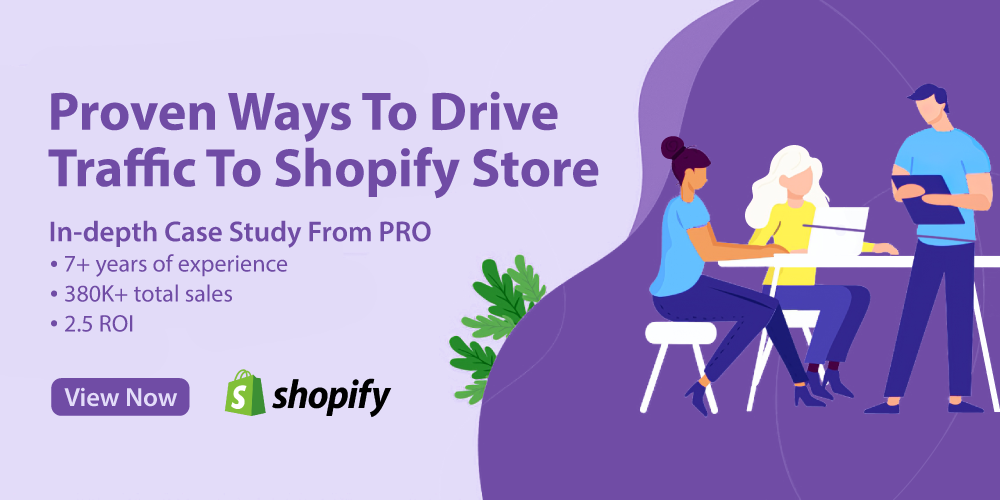Are you eager to discover the hottest tactics to boost traffic to your Shopify store or level up your brand-new eCommerce business? Generating more traffic has always been a crucial part of growing your eCommerce Business.
In this article, you will explore the various types of traffic, a wealth of traffic-generating strategies, and a compelling case study from a professional eCommerce expert near the end. You can find out a variety of effective ways to drive traffic in every budget that will help your business grow.
11 expert-proven ways to drive traffic to your Shopify Store
Understanding different types of traffic is the first step. Now, let’s move on to reviewing the 10 most effective strategies to help you get more highly convertible traffic.
Optimize SEO to increase your store’s discoverability | Organic Traffic
1. Write SEO-friendly titles
Pros: low cost; low effort; long-term traffic
Cons: slow results
Both the meta titles and descriptions of your page play a vital role in its appearance on search engine results pages. They are crucial in generating clicks and organic traffic, which is the lifeline of your website. In fact, Google considers them as one of the key metrics in determining the order of search results. According to Google, meta titles provide users with a quick understanding of the content and its relevance to their query and are often the deciding factor in which result to click on. Therefore, it is crucial to ensure high-quality titles on your web pages to help you stand out from the crowd.
Our recommendation is to prioritize the following tips while creating meta titles:
- Include targeting keyword
- Short meta titles in less than 55 characters
- Keep consistency with the title you use across your pages
2. Add internal links to and from high-authority sites
Pros: low cost; long-term traffic
Cons: High effort; slower ROI up to weeks
While obtaining external links is a well-known strategy to enhance search engine optimization (SEO), internal links also play a crucial role in boosting page ranking in search engines. This is due to Google’s PageRank metric, which evaluates a page’s significance and worth based on the quantity and quality of pages linking to it.
It is beneficial to link from pages with a high PageRank within the same domain to improve the ranking of a target page. Conversely, linking from lower-priority pages to high-priority pages on the website can also transfer the PageRank back to the priority pages. This way, internal links can help to boost the authority of individual pages and improve their overall ranking in search engine results.
- Submit your sitemap via Google Search Console
- Add a high authority internal link to your target page(s).
- Incorporate the link with a high-relevance anchor text to your target page
3. Enrich Your snippets to stand out
Pros: affordable cost; long-term traffic
Cons: High effort; slower ROI up to weeks
Rich snippets are enhanced search listings that display important information about a product, such as its price, availability, and review count. They offer a convenient way to gain insights about a particular product or website without having to navigate to it.
Implementing rich snippets on your website can significantly increase your traffic from search engines. According to a study by Search Engine Land, adding rich snippets can boost click-through rates by up to 30%. In contrast, increasing your marketing or ad spending by 30% would require a significant investment.
It’s recommended to include additional information such as a price range, star rating, or image, it will stand out from other search results that only display standard meta titles, descriptions, and URLs. As a result, your page will attract more traffic and potentially more customers.
Create high-quality content to attract targeted customers | Organic Traffic
4. Write in-depth blogs and articles to provide solutions
Pros: low cost; long-term traffic
Cons: Medium effort; slower ROI up to months
According to WordPress, over 409 million people per month viewed more than 20 billion blog pages in 2023 on its platform. While users of the platform create approximately 70 million new posts and 77 million new comments during the same period.
Although there is significant potential to reach a large audience, generating traffic to your store through blogging. The most effective method involves producing content that solves problems while being easily discoverable by search engines. Achieving this requires the skills of a skilled content marketer, who must undertake tasks such as customer journey mapping, persona building, keyword research, and content gap analysis.
5. Create videos to educate or entertain
Pros: affordable cost; long-term traffic
Cons: High effort; slower ROI up to months
YouTube would be your best channel for generating video traffic in 2023, as well as being the second-largest search engine in the world. According to YouTube, there are over two billion users (nearly 1/3 of all internet users), particularly among 18-34 year-olds, with more than 70% of YouTube views happening on mobile devices.
To effectively reach the right audience on YouTube and drive traffic back to your store, you need to create targeted content. Here are some content ideas that your business could consider:
- Resourceful/Educational. Create trustworthy content by teaching or educating new knowledge. Incorporate your product as the solution to their problem.
- Entertainment. Catch your viewer’s attention with fun videos.
Reach out to new audiences with influencer marketing | Referral Traffic
6. Send free samples to social influencers
Pros: affordable cost; short-term traffic
Cons: High effort; relatively slow ROI up to weeks
According to Yotpo, there are at least 30% of Instagram users have made a purchase from the platform, which makes Instagram one of the most effective marketing channels for e-commerce businesses.
Social media celebrities and influencers are highly trusted by their followers, which makes them your best advertiser to feature your products in an organic way for increasing your traffic. One of the most popular promotional ways is to sponsor them to try out your products for free and host a giveaway with some exclusive discounts to their audience. This combination can increase your brand awareness and boost conversion in a short period of time.
7. Reach out to press and bloggers
Pros: affordable cost; short-term traffic
Cons: High effort; slower ROI up to weeks
To achieve measurable success in your business through blogger outreach, it’s crucial to understand that it goes beyond simply making online friends. The key to success lies in providing value and clearly communicating the benefits for the bloggers. Simply asking for help from well-meaning individuals is unlikely to work since everyone is busy with their own tasks.
Here are some outreach ideas to help you generate traffic:
- Guest posting on their blogs. This is a great strategy to help you get in front of someone else’s. Make sure to add an external link back to your site to increase traffic. This might be time-consuming, but it is a powerful method to help you generate backlinks.
- Search for affiliates to promote your business. Ask other bloggers to help you drive traffic by offering them an affiliate link coordinate with a commission on each conversion sale they generate.
- Publish on press coverage. Try to send your products with an interesting story to the press and media. You can also get in touch with journalists or bloggers who cover similar audiences like yours and exchange guest posts with them.
Engage on social media | Social Traffic
8. Ask family and friends to share
Pros: low cost; short-term traffic
Cons: Medium effort; slower ROI up to weeks
When starting a business, leveraging the support of friends and family can be one of the most effective and efficient strategies for generating initial awareness, traffic, and even sales. Since starting a business is not a common occurrence within your social circle, your loved ones are likely to be excited to share news about your brand-new online store with others.
Consider the success story of Upworthy, which gained momentum through the support of friends and family, setting a goal of 1,000 Facebook fans on launch day and achieving it. It eventually worked and gave him the initial traction to take off his business.
To effectively reach out to friends and family, ask for support in the form of sharing your store with their networks instead of focusing on selling products. Since you have social equity with these individuals, they are more likely to be receptive to your request and help spread the word. This can lead to a steady stream of customers and help your business gain momentum.
9. Enhance engagement rate and drive new traffic with giveaways
Pros: short-term traffic; fast ROI up to days
Cons: High effort; medium to high cost
Hosting contests and giveaways is an effective way to increase your Instagram followers, boost engagement on social media, and drive traffic to your website. Research indicates that after registering for a contest or giveaway, 94% of users immediately share the promotion, and 62% encourage their friends to participate as well.
With viral contests, giveaways, and sweepstakes, you can attract more customers to visit your store with the promise of exciting prizes. Incentives are powerful motivators for both existing and potential customers to engage with your brand.
Here are some popular tools for hosting contests & giveaways:
- Gleam
- Woobox
- Social Boost Giveaways Contest
- Other contest giveaway apps on Shopify
10. Offer limited-time discounts
Pros: Fast ROI up to days; short-term traffic
Cons: High effort; medium to high cost
By offering time-sensitive discounts, you can prompt people to act promptly, boosting traffic and sales. When you attach an expiration date to your discount, you create a sense of scarcity, which is a potent psychological factor that drives sales.
Newer stores can benefit from setting a minimum purchase limit to avoid excessive discounting. This strategy helps maintain a balance between providing a valuable incentive for your followers and avoiding giving away too much which harms your profit in the long term.
11. Unlock advertising with Premium Agency
Pros: Low effort; long-term traffic
Cons: High cost
Agency Ad Accounts are accounts obtained and approved directly by META and distributed through ASP (Authorized Seller Partners). Some advantages of these accounts are:
- Increased lifespan: preapproved by META, therefore, immune to errors in META Algorithm updates. No more waiting 2 weeks after applying for reviews.
- No spending limits: agency accounts are not subject to regular ad spend limits allowing you to scale freely.
- Analytical data: agency accounts last longer preserving analytical data from past campaigns to improve future ones.
ScaliX Agency is a professional tool to embark on an advertising journey, a setup based on Strong Agency Ad Accounts. Enables your advertising beyond any spending limits or unjustified restrictions. Selecting the right ad agency offers several benefits, including improved ad performance, access to advanced tools, cost savings, enhanced branding and reputation, ongoing optimization, monitoring, etc.
Last but not least, running paid promotions and advertisements is considered one of the most effective ways to drive traffic in the short run. By investing in paid ads, you can create targeted campaigns that reach potential customers who are more likely to be interested in your products or services. This can increase the likelihood of clicks and conversions, ultimately leading to more revenue for your business.
A real-life case study can provide a deeper understanding of how paid promotions and advertisements can benefit your business. Through this case study from our eCommerce expert with more than 7 years of experience in the industry, you can learn about the strategies used, the challenges faced, and the results achieved.
Results-proven Case Study From Pro
Introduction of Jojo – HyperSKU‘s eCommerce Expert
Jojo was one of the co-founders of a large-scale dropshipping company with over 7 years of management and operational experience in the eCommerce industry. This will be a great opportunity to learn from our professional expert who had over 3 years of experience in managing meta ads accounts with over 10 million ads budget in a year. Discover the best ways to generate traffic to your Shopify store and build converting ad campaigns from Jojo’s real-life case study below.

Different types of website traffic and their sources well explained
Knowing where your visitors come from and where your highest traffic was sourced will help you map your next step in generating more sales.

Source from Sixads
1. Organic Traffic
Organic traffic comes from search engine results pages (SERPs), mainly sourced from search engines like Google, Bing, and Yahoo. This type of traffic can account for a highly significant percentage of visits in the long run. It is also considered to be the most valuable type of traffic because it’s free and highly targeted to your direct audience.
The benefits of Organic Traffic:
1. Higher Conversion Rate
Organic results attract about 50% more clicks than paid links and put your website in front of a highly targeted audience who are ready to buy. This will eventually lead to a better conversion rate for your business.
2. Builds brand awareness
Having your website discovered organically with frequent repetition, increases the likelihood of individuals taking note of your website and subsequently visiting it. Over time, this can result in stronger retention of your brand story and increase the chances of these individuals returning to your site when in need of your products or services.
3. Higher Credibility & Consistency
Research indicates that the majority of individuals tend to overlook paid results and instead opt for the top organic results, much like yourself. Results show that 75% of clicks are organic and only 20% would click on paid ads. This finding further supports the notion that people place greater trust in organic traffic as a reliable source of information.
It takes an average of 6 to 8 touchpoints before your potential leads are ready to make a purchase. This finding highlights the significance of a consistent and methodical approach to building up your organic traffic. By doing so, you can ensure that your business is well-positioned to influence potential customers throughout their decision-making process and ultimately drive sales.
2. Direct Traffic
Direct traffic has no discernible point of origin. Visitors might already know your URL or have visited your site before.
Direct traffic can be sourced from the following origins, but not limited to:
- Visitors who have bookmarked your website’s URL and clicked through it.
- Visitors who typed your URL into their search bar manually
- Visitors who have clicked on a link in an opened email
- Inappropriate page redirections
3. Referral Traffic
Referral traffic refers to visitors who entered your website by clicking on a link from another site.
Here are some of the legitimate sources for referral traffic:
- Guest posts
- Bios and info snippets
- Review and ranking sites
- Blog posts or articles with a direct link to your website
- Images, videos, and infographics
4. Social Traffic
This type of traffic refers to the traffic coming to your website directly from social networks and social media platforms, which includes the sources below.
- Youtube
- Tiktok
- Email (dark social)
- Text Messages (dark social)
- Messaging networks like Whatsapp, Snapchat, Telegram, Facebook, etc. (dark social)
There are two types of social traffic, public social and dark social which are mentioned above. The only differentiation is that social traffic is coming from open social media platforms that are easy to track and dark social are usually less open and harder to track. Keep in mind that a lot of dark traffic may end up as direct traffic if your links have failed to be tagged appropriately.
5. Paid Traffic
This type of traffic refers to visitors who arrive at your website after clicking on a paid link on a social network, advertisements, or other PPC platforms.
In general, paid traffic can come from these sources:
- Social media ads (Youtube, Facebook, Instagram, etc.)
- Display ads (Google Adsense, media, Facebook Network Audience Ads, etc.)
- Search engine ads (PPC from Google ads)
6. Email Traffic
Email Traffic refers to any traffic that comes to your website from email marketing campaigns via tagged links.
Latest articles you might be interested in:
- Discover Top 20 Dropshipping Suppliers for Your Online Business
- 5 Steps to Master Shopify Dropshipping for Profitable Business
- Biggest Dropshipping and eCommerce Trends For 2023
- Shopify Edition Winter ’23: Top New Features You Should Know
Shopify Edition Winter ’23: Top New Features You Should Know


